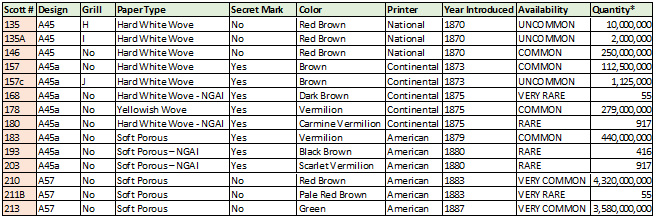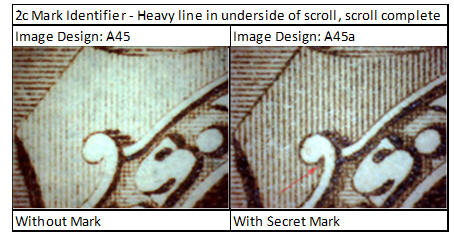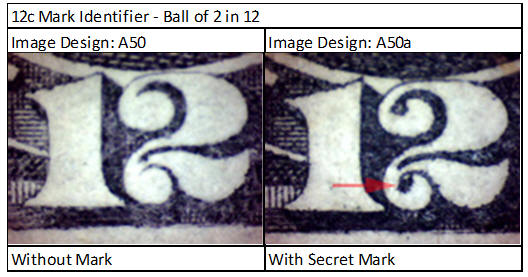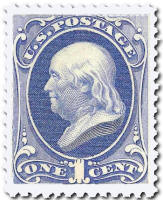We will include every stamp issued between
1870-1889 in the text discussion of each stamp denomination, as well as in
an individual matrix following each. Between these two and with the visual
aid of the 1873 Issue secret marks and the 1882 Re-engraved designs, the
positive identification of all of the large Banknote stamps should be easy.
The 1873 Issue stamps (and the 1875 2c and 5c) exist with a “J” grill
(1c-30c are reported) which is considered to be experimental in nature,
therefore it is not included in our text article. For the purpose of this
document, all numbers refer to Scott Specialized catalog number. The three
Banknote printing companies produced the following Post Office Contract
issues and their product is identified by certain unique characteristics as
follows;
NATIONAL BANKNOTE COMPANY – 1870 Issue with Grill 134-144,
134A-144A and without grill 145-155. Characteristics are; grilled or
ungrilled, both on hard paper.
Tip – The ability to identify hard and soft
paper is important, so a few words on that subject;
HARD PAPER – Stiff, whiter than soft paper, not translucent
when held to light (the paper weave appears more “solid” than soft, which
has a distinct mesh), appears whiter under UV long wave light (because it is
less dense than soft paper), perf tips appear more solid when viewed with
good magnification (recommend 10-15X) than soft paper (which will display
more paper fibers on the perf tips). Detect hard paper by observing the
traits already noted. Some people can also ID hard paper by “flicking” the
edges and feeling the stiffness of the paper versus the softness of soft
paper.
SOFT PAPER – A looser-weave paper than hard, so feels
softer, displays a weave when held to light, looks grayer under UV light
than hard, and shows lots of perf tip fibers with good magnification.
Tip – Learn to identify the differences
between hard and soft paper by studying them both using reference copies of
stamps that MUST be on one of the papers. For hard, any stamp of the 1861-67
series is good (a 3c used 65 cost is under $2.00) and for soft use any
1883-1889 Issue stamp or even an 1893 Columbian stamp.
CONTINENTAL BANKNOTE COMPANY – 1873-1875 Issues. 156-166,
167-177 Special Printings, 178-179, 180-181 Special Printings.
Characteristics are hard paper (except later printings which were on an
“intermediate” weave paper) and secret marks added to the plates (except the
24c, 30c and 90c). Most values also exist with a “J” grill, which students
have concluded is experimental, thus they are not assigned major catalog
numbers by Scott. A color change 178 and a design change 179.
SPECIAL PRINTINGS – Were issued to be sold to collectors
and, in the case of the 1875 printings, because the Post Office wanted a
display of every stamp issue prior to 1875 for display at the 1876
International Exhibition in Philadelphia, PA. Most of them are so rare that
the chances of ever encountering one is minute, but they are included, for
accuracy, as part of the matrix additions to the text. In a few cases, we
will make special notes as “Tips” after the main text to explain an
important fact about a stamp you may (if you are very lucky!) actually
encounter.
AMERICAN BANKNOTE COMPANY – 1879-1889 Issues 182-191,
192-204 Special Printings, 205, 205C Special Printing, 206-218, 211B and
211D Special Printings. Characteristics – Soft paper, design changes,
re-engraved issues. Tips – Design of 182-191 are the same as the earlier
1c-90c sets. Design or color changes include 206-209 (which are re-engraved
designs with rather easy differences from the earlier similar-design issues
which we will describe in the text for those denominations) and 210-218.
LISTINGS BY DENOMINATION (Most common to scarcest)
1c Values
1. 1881 Re-engraved Issue
206; is identified by the strengthening of the background lines in the upper
part of the
design
such that the area appears nearly solid;
2. 1887 Issue 212; new
design on soft, porous paper;
3. 1879 Issue 182; on soft
porous paper;
4. 1873 Issue 156; on hard
paper with secret mark (In the first pearl to the left of the numeral “1”
there is a tiny
crescent-shaped line);
5. 1870 Issue without grill
145; on hard paper;
6. 1870 Issue with “H”
grill 134; on hard paper;
7. 1870 Issue with “I”
grill 134A;
Tip – “I” grill is smaller than “H” grill,
usually consisting of 10-11 vertical rows and 10-13 horizontal rows, while
“H” grills are usually larger 11-13 X 14-16 rows.
8. Special Printings (see matrix).


2c Values
1. 1883
Issue 210; soft paper, new design;
2. 1889
Issue 213; same design as 210 in new color (green);
3. 1879
Issue 183; soft paper, same design as 1870-73 Issues but new color
(vermilion);
4. 1875
Issue 178; hard paper, same color and design as 183;
5. 1870
Issue without grill 146; hard paper, color is light or reddish brown;
6. 1873
Issue 157; hard paper, sometimes shows a secret mark (under the scroll to
the left of “US” there is a
small
diagonal line. It seldom shows clearly, if at all, and Scott assigns a
different value to it if it is without the
secret
mark). When the secret mark is not present, it can only be differentiated
from the 1870 ungrilled issue
by the
color, which is always darker brown;
Tip – This stamp is found on ribbed paper and
actually is the value of the 1873 Issue that is most often seen with this
paper variety. Ribbed paper is considered
unique to the 1873-75 Issues produced by Continental Banknote Company,
even though a few copies have been reported
on the 2c 1870 ungrilled stamp as well. Ribbed paper is difficult for
many collectors/dealers to see as it is only
really visible by viewing the stamp across reflected light so that the light
is directed downward at the stamp which is held at
a slight diagonal angle between your eyes and the light. All of the
values which exist on ribbed paper are a premium
in Scott, which is why it pays to be able to identify it. And the
“grand prize” is the fact that the only reported
copy of the 24c 1873 Issue 164 is on ribbed paper (see further
discussion under 24c values).
7. 1870 Issue with “H” Grill 135; on
hard paper;
8. 1870
Issue with “I” Grill 135A; hard paper;
9. Special
Printings.
Tip – The Special
Printing of the 1883 2c (211B, issued in 1885) may be encountered. It
can be identified by a printing
difference which is not noted by
catalogs, but is well-known to students. The cross-hatched designs located
between
the bottom of the bust at the left and
the left oval vignette line extend all the way to the bottom of that area,
whereas
on the 1883 2c, the tiny crosshatch lines
stop well up from the bottom of that area.
Tip – the 2c 1880 Special Printing on
soft paper 193 is easy to identify as it is the same design as the 2c
1870-73
Issues but is on soft paper and the color
is black brown. It is very rare, with only 416 copies reportedly issued. It
is
remotely possible that you might find one
if you can easily identify soft paper.


3c Values
1. 1882 Re-engraved Issue 207; soft paper, design is identified by the addition of a small horizontal dash below
the right ribbon at bottom right and by the shading that projects from the oval around the center design being
greatly reduced in size from previous issues;
2. 1873 Issue 158; identified by hard paper and addition of secret mark (shading in bottom left ribbon greatly
darkened);
3. 1879 Issue 184; soft paper, same design as 1873 issue;
4. 1870 Issue without grill 147; hard paper, no secret mark, color generally a lighter shade of green than 1873
issue which is usually found bluish green;
5. 1870 Issue with “H” Grill 136;
6. 1887 Issue (Scott 214); change of color ( vermilion);
7. 1870 Issue with “I” Grill 136A;
8. Special Printings (See Matrix).

 4c Values
1. 1883
Issue 211; soft paper, blue green;
2. 1887
Issue 215; color change, carmine;
3.
Special Printing 211D.
4c Values
1. 1883
Issue 211; soft paper, blue green;
2. 1887
Issue 215; color change, carmine;
3.
Special Printing 211D.
 5c Values
1. 1882
Issue 205; New Design, Garfield, Yellow Brown;
2. 1888
Issue 216; same, blue;
3. 1879
Issue 185; same as 1875 new design, Taylor, soft paper;
4. 1875
Issue 179; new design, Taylor, hard paper;
5. 1882
Special Printing 205C.
5c Values
1. 1882
Issue 205; New Design, Garfield, Yellow Brown;
2. 1888
Issue 216; same, blue;
3. 1879
Issue 185; same as 1875 new design, Taylor, soft paper;
4. 1875
Issue 179; new design, Taylor, hard paper;
5. 1882
Special Printing 205C.
 6c Values
1. 1873
Issue 159; hard paper, secret mark (in bottom left ribbon design the first
four vertical shading lines are
6c Values
1. 1873
Issue 159; hard paper, secret mark (in bottom left ribbon design the first
four vertical shading lines are
strengthened);
Tip – This stamp can also, aside from the
presence of the secret mark, usually be ID by the color, which is a lighter
shade than the 1870 issues.
2. 1870
Issue Without Grill 148; hard paper, carmine, no secret mark;
3. 1879
Issue 186; soft paper;
4. 1882
Re-engraved Issue 208; soft paper; on the earlier 6c there are four vertical
lines at the left outer design
whereas on
the re-engraved there are three;
5. 1870
Issue with “H” Grill 137;
6. 1870
Issue with “I” Grill 137A;
7.
Special Printings (See matrix).

 7c Values
1. 1873 Issue 160; hard paper, secret
mark (Two small semi-circles added at the indented lines at lower right
corner);
2. 1870 Issue Without Grill 149; hard
paper, no secret mark;
3. 1870 Issue With “H” Grill 138;
4. 1870 Issue With “I” Grill 138A;
5. Special Printings; Note that the
1880 7c Special Printing 196 is easy to identify because there is no other
7c Values
1. 1873 Issue 160; hard paper, secret
mark (Two small semi-circles added at the indented lines at lower right
corner);
2. 1870 Issue Without Grill 149; hard
paper, no secret mark;
3. 1870 Issue With “H” Grill 138;
4. 1870 Issue With “I” Grill 138A;
5. Special Printings; Note that the
1880 7c Special Printing 196 is easy to identify because there is no other
corresponding 7c on soft paper.

 10c Values
1. 1882 Re-engraved Issue 209; soft
paper, differs from the earlier 10c values by having only four vertical
lines
10c Values
1. 1882 Re-engraved Issue 209; soft
paper, differs from the earlier 10c values by having only four vertical
lines
between the left side of the oval and the
shield. There is also a layout dot located in the white oval directly
across from Jefferson’s nose;
2. 1873 Issue 161; hard paper, secret
mark (tiny semi-circle added to the scroll at the right end of the upper
label);
3. 1870 Issue Without Grill 150; hard
paper, no secret mark;
4. 1879 Issue With Secret Mark 188;
soft paper;
5. 1879 Issue Without Secret Mark 187;
soft paper;
6. 1870 Issue With “H” Grill 139;
7. 1870 Issue With “I” Grill 139A;
8. Special Printings (see matrix).

 12c Values
1. 1873 Issue 162; hard paper, secret
mark (the left balls of the figure “2” are crescent shaped;
2. 1870 Issue Without Grill 151; hard
paper, no secret mark;
3. 1870 Issue With “H” Grill 140;
4. Special Printings; Note that 12c
1875 SP is easy to identify because there is no other corresponding 12c
value
12c Values
1. 1873 Issue 162; hard paper, secret
mark (the left balls of the figure “2” are crescent shaped;
2. 1870 Issue Without Grill 151; hard
paper, no secret mark;
3. 1870 Issue With “H” Grill 140;
4. Special Printings; Note that 12c
1875 SP is easy to identify because there is no other corresponding 12c
value
on soft paper;
5. 1870 Issue With “I” Grill 140A.

 15c Values
1. 1879 Issue 189; soft paper;
2. 1873 Issue 163; hard paper, secret
mark (note that the 15c secret mark is contentious, but catalogers describe
15c Values
1. 1879 Issue 189; soft paper;
2. 1873 Issue 163; hard paper, secret
mark (note that the 15c secret mark is contentious, but catalogers describe
it as the lower part of the upper left
triangle “V” is strengthened. It is our opinion that this stamp is best
defined by
the color shade, which is a darker orange
than usually found on the 1870 Issues, and darker still if on ribbed paper);
3. 1870 Issue Without Grill 152; hard
paper, no secret mark, color is a lighter orange than the 1873 Issue;
4. 1870 Issue With “H” Grill 141;
5. 1870 Issue With “I” Grill 141A;
6. Special Printings (see matrix).


24c Values
1. 1870 Issue Without Grill 153; hard paper;
2. 1870 Issue With “H” Grill 142;
3. Special Printings; note that the 1890 24c SP is easy to identify because there is no other corresponding
24c value on soft paper;
4. 1873 Issue 164; only one copy of this stamp is certified. It can only be identified because it is on vertically
ribbed paper which is considered to be unique to the Continental BNCo. While students believe Continental
printed more 24c stamps, as of now, there is no other way to differentiate them from National stamps except if
on ribbed paper.
 30c Values
1. 1879 Issue 190; soft paper;
2. 1887 Issue 217; new color (orange brown);
3. 1873 Issue 165; hard paper (Note that since Continental BNCo did not make new plates for the 30c or 90c
stamps, the only way to differentiate the 1873 stamps from the 1870 is by color shade, which is usually gray
black, greenish black, or light black);
4. 1870 Issue Without Grill 154; hard paper, usually dark black color shade;
5. 1870 Issue With “H” Grill 143;
6. Special Printings (see matrix);
7. 1870 Issue With “I” Grill 143A.
30c Values
1. 1879 Issue 190; soft paper;
2. 1887 Issue 217; new color (orange brown);
3. 1873 Issue 165; hard paper (Note that since Continental BNCo did not make new plates for the 30c or 90c
stamps, the only way to differentiate the 1873 stamps from the 1870 is by color shade, which is usually gray
black, greenish black, or light black);
4. 1870 Issue Without Grill 154; hard paper, usually dark black color shade;
5. 1870 Issue With “H” Grill 143;
6. Special Printings (see matrix);
7. 1870 Issue With “I” Grill 143A.
 90c Values
1. 1888 Issue 218; soft paper, new color (purple);
2. 1873 Issue 166; hard paper, can only be differentiated from the 1870 issues by color, which is lighter;
3. 1870 Issue Without Grill 155; hard paper, dark carmine color;
4. 1879 Issue 191; soft paper;
5. 1870 Issue With “H” Grill 144;
6. 1870 Issue With “I” Grill 144A;
7. Special Printings (see matrix).
90c Values
1. 1888 Issue 218; soft paper, new color (purple);
2. 1873 Issue 166; hard paper, can only be differentiated from the 1870 issues by color, which is lighter;
3. 1870 Issue Without Grill 155; hard paper, dark carmine color;
4. 1879 Issue 191; soft paper;
5. 1870 Issue With “H” Grill 144;
6. 1870 Issue With “I” Grill 144A;
7. Special Printings (see matrix).

The 1870-1890 Issues present many challenges to correct identification
because there were multiple different issues by three different Banknote
companies, using different paper types, and involving design and color
changes. This article will attempt to simplify this subject by presenting
the stamps in the order, by denomination, that collectors are most likely to
encounter them, from most common, to scarcest (based on Scott Specialized
Catalog USED prices).




















30c Values 1. 1879 Issue 190; soft paper; 2. 1887 Issue 217; new color (orange brown); 3. 1873 Issue 165; hard paper (Note that since Continental BNCo did not make new plates for the 30c or 90c stamps, the only way to differentiate the 1873 stamps from the 1870 is by color shade, which is usually gray black, greenish black, or light black); 4. 1870 Issue Without Grill 154; hard paper, usually dark black color shade; 5. 1870 Issue With “H” Grill 143; 6. Special Printings (see matrix); 7. 1870 Issue With “I” Grill 143A.
90c Values 1. 1888 Issue 218; soft paper, new color (purple); 2. 1873 Issue 166; hard paper, can only be differentiated from the 1870 issues by color, which is lighter; 3. 1870 Issue Without Grill 155; hard paper, dark carmine color; 4. 1879 Issue 191; soft paper; 5. 1870 Issue With “H” Grill 144; 6. 1870 Issue With “I” Grill 144A; 7. Special Printings (see matrix).